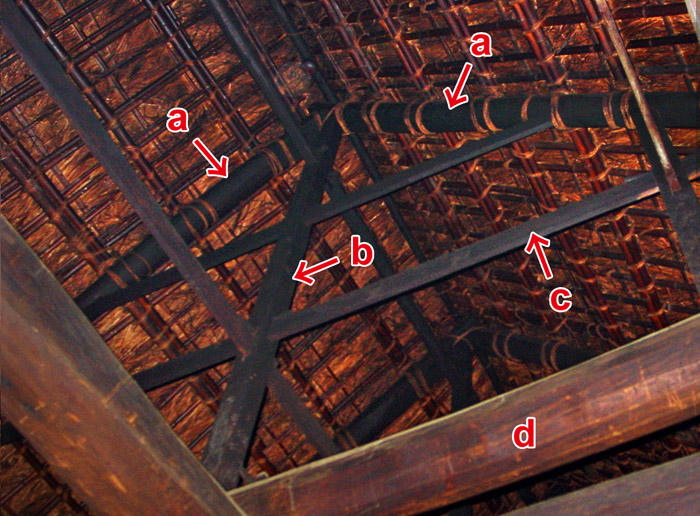|
||
 |
||
2 Also referred to as *gasshou 合掌. Originally sashu 叉手 or 扠手, denoting hands clasped together with the fingers interlocked. On a vernacular house *minka 民家, of the Edo period, a pair of sloping upper cruck-like members joined together at the top to support the ridge purlin *munagi 棟木, of a thatched roof. They were usually straight stripped logs, but otherwise unwrought. Their feet were sharpened to a point and inserted into the mortise holes *hozoana ほぞ穴, at either end of the main span beams *jouyabari 上屋梁, *koyabari 小屋梁, which formed the base for the triangular roof frame. At the apex the sasu were either lashed together with straw twine nawa 縄, or joined with a tenon nagahozo 長ほぞ, and mortise. The projecting end was held in place with a peg *hanasen 鼻栓. The ridge purlin was cradled in the crotch formed by the intersection of the sasu. Sometimes a vertical strut *sasuzuka 扠首束 was placed beneath the intersection to prop up the ridge directly and give added stability. See *sasugumi 扠首組 and *gasshou-zukuri 合掌造.
3 Stakes of thorn ibara 茨, bound together in pairs, with their tops crossed over, to form an inverted 'v', in section, and then placed together in a row to form a fence *kakine 垣根, or screen to keep enemies at bay. Used in the castles and townships of the medieval period.
4 A term for rafters *taruki 垂木, in the vernacular house *minka 民家, of parts of Gunma and Nagano prefectures.

(C)2001 Japanese Architecture and Art Net Users System. No reproduction or republication without written permission.
掲載のテキスト・写真・イラストなど、全てのコンテンツの無断複製・転載を禁じます。

